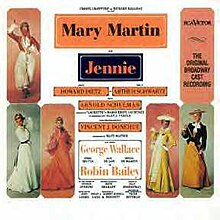Jennie(musical)
| Jennie | |
|---|---|
 Original Cast Recording | |
| Music | Arthur Schwartz |
| Lyrics | Howard Dietz |
| Book | Arnold Schulman |
| Basis | The life ofLaurette Taylor |
| Productions | 1963Broadway |
Jennieis amusicalwith a book byArnold Schulman,music byArthur Schwartz,and lyrics byHoward Dietz,and starredMary Martin.
The plot focuses on actors and married couple Jennie Malone and James O'Connor, who tour the country in popularmelodramas.Much of the action consists of elaboratespoofsof the type of entertainment offered to audiences in the early 20th century.
Background
[edit]In the late 1950s, the project began as an account ofactressLaurette Taylor's early life and career, based on abiographywritten by her daughter Marguerite Courtney. While it was still in its early stages, a non-musical adaptation of the book starringJudy Hollidayclosed after a week inNew Haven.Undaunted, the creative team forged ahead, tailoring what was then calledBlood and Thunderspecifically for the talents ofMary Martinwho, with her husband Richard Halliday, agreed to produce the show withCheryl Crawford.Martin and Halliday financed half of the $500,000 production costs and Crawford andAlan Pakulathe other half.[1]
S. N. Behrmanused Taylor's son Dwight's biography as a source for the musical's book, which centered on Taylor's husband Charles and the various women in his life, all portrayed by Martin. His book ultimately was abandoned, and Schulman was called in to write a new version, whichfictionalizedthe story and its characters. The end result bore no resemblance to either the original concept or Taylor.[2]
Productions
[edit]- Out-of-town tryouts
Jenniewas plagued with problems from the start. InBoston,the major character of Jennie's second husband (J. Hartley Manners, who was to be played by Robin Bailey) was eliminated, andCarol HaneyreplacedMatt Mattoxas choreographer. Schwartz suedThe Boston Globeand its critic Kevin Kelly, on the basis that his review implied the composer had "stolen or plagiarized" from other composers.[3]In summarizing the Boston reviews,The New York Timesnoted that while the critics unanimously praised Martin, they were "disappointed" in the show. It was "too long, too cultured, and sometimes even too solemn for its own good", according to Elliot Norton ofThe Record American.[4]
InDetroit,the leading man was replaced (George Wallace replaced Dennis O'Keefe),[5]and animosity developed between Schwartz and Dietz and the Hallidays, who decided not to bring the show toNew York City.When the composers threatened to sue the couple for the $1.35 million advance sale, they agreed to open as scheduled.[2]
- Broadway
The musical opened onBroadwayat theMajestic Theatreon October 17, 1963 and closed on December 28, 1963, after 82 performances and four previews. Directed byVincent J. Donehue,choreographed by Matt Mattox (official IBDB credits) and with costumes byIrene Sharaff,the cast includedGeorge D. Wallaceas O'Connor,Robin Baileyas Cromwell, Jack De Lon as Abe O'Shaughnessy,Jeremiah Morrisas The Bear, Sydney Harris, and Indian Fakir, andEthel Shuttaas Nellie Malone.
The critics were delighted by the score and Martin'sslapstickantics but found little else to praise. Howard Taubman, inThe New York Timeswrote: "Not that Miss Martin has lost her luster...she continues to be a game and resourceful trouper, willing to do an impossible backbend while being carried aloft and game enough to let herself be whirled head over heels on a torture rack and come up smiling and belting out a top note."[6]Walter Kerrreviewing in theHerald Tribunewrote: "a woeful tale of some woeful people told in a woeful way."[7]This was Martin's first Broadway flop. (She had starred inNice GoinandDancing in the Streetswhich closed out-of-town.Dancingwas written byVernon Dukeand Howard Dietz, and closed in Boston in 1943.)[8] [9]
TheNew York Timesreported the show’s losses as $450,000.[10]
Synopsis
[edit]In 1906 Jennie Malone and James O'Connor tour the United States in popularmelodramas;they are both an acting team and married couple. In a small town in South Dakota, Jennie is appearing in the play "The Mountie Gets His Man, or Chang Lu, King of the White Slaver", and must perch on a tree limb, which lowers her over a fake waterfall. In another play, Jennie plays Shalimar in "The Sultan's Last Bride" with bells on her fingers. Jennie and James, with cane and straw hat, do a soft-shoe dance in another show.
When Jennie leaves her husband the EnglishplaywrightChristopher Lawrence Cromwell offers her work.
Song list
[edit]
|
|
Recording
[edit]Anoriginal cast recordingwas released byRCA Victor(ASIN: B000003F4Z) in October 1963.
Notes
[edit]- ^Zolotow, Sam."Two Leading Men Signed by Jennie",The New York Times,April 30, 1963, p. 27
- ^abDavis, Ronald L."Hits and a Miss", Chapter 11 ",Mary Martin, Broadway legend(2008), University of Oklahoma Press,ISBN0-8061-3905-6
- ^"Song Writer Suing Boston Stage Critic"The New York Times,August 14, 1963, p. 29 (archive abstract accessed August 10, 2016)
- ^"2 New Musicals Assayed on Road"The New York Times,July 31, 1963, p. 19 (archive abstract accessed August 10, 2016)
- ^Wilson, John S. "The Life of 'Jennie'",The New York Times,October 13, 1963, p. 119
- ^Taubman, Howard."Theater: Mary Martin Stars in 'Jennie'"The New York Times,October 13, 1963, p. 28 (archive abstract accessed August 10, 2016)
- ^Davis, p. 231
- ^"Mary Martin"Archived2012-01-24 at theWayback Machinepbs.org, accessed August 5, 2009
- ^"Mary Martin Biography"allmusic, accessed August 10, 2016
- ^Calta, Louis. “10 Hits Help Broadway Rebound from Losses of 1962-63 Season.” New York Times, 29 June 1964, 1.
References
[edit]Not Since Carrie: Forty Years of Broadway Musical FlopsbyKen Mandelbaum,published bySt. Martin's Press(1991), pages 53–55 (ISBN0-312-06428-4)
